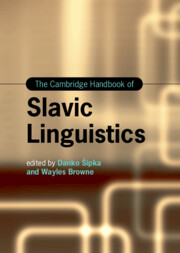Book contents
- The Cambridge Handbook of Slavic Linguistics
- Cambridge Handbooks in Language and Linguistics
- The Cambridge Handbook of Slavic Linguistics
- Copyright page
- Contents
- Figures
- Tables
- Contributors
- Introduction
- Part 1 Prosody and Phonology
- Part 2 Inflectional and Derivational Morphology
- 7 Inflectional Endings: Declensions
- 8 Inflectional Endings: Conjugation
- 9 Tense and Mood Forms
- 10 Aspect in Verbs
- 11 Lexical Derivation
- 12 Lexical Composition
- Part 3 Syntax
- Part 4 Lexicon
- Part 5 Sociolinguistic and Geographical Approaches
- Part 6 Experimental and Quantitative Approaches
- Name Index
- Subject Index
- References
10 - Aspect in Verbs
from Part 2 - Inflectional and Derivational Morphology
Published online by Cambridge University Press: 16 May 2024
- The Cambridge Handbook of Slavic Linguistics
- Cambridge Handbooks in Language and Linguistics
- The Cambridge Handbook of Slavic Linguistics
- Copyright page
- Contents
- Figures
- Tables
- Contributors
- Introduction
- Part 1 Prosody and Phonology
- Part 2 Inflectional and Derivational Morphology
- 7 Inflectional Endings: Declensions
- 8 Inflectional Endings: Conjugation
- 9 Tense and Mood Forms
- 10 Aspect in Verbs
- 11 Lexical Derivation
- 12 Lexical Composition
- Part 3 Syntax
- Part 4 Lexicon
- Part 5 Sociolinguistic and Geographical Approaches
- Part 6 Experimental and Quantitative Approaches
- Name Index
- Subject Index
- References
Summary
This chapter addresses verbal aspect in Slavic languages. It first defines main concepts, such as perfective and imperfective verbs. Next, it outlines the distribution of perfective and imperfective verbs in the following situations: states, activities, accomplishments, achievements, and semelfactiveness. The chapter then presents usage types of verbal aspect in Slavic languages, differentiating the western and the eastern types. The next section discusses verbal aspect in a diachronic perspective. The final section of this chapter outlines current lines of research in the field of Slavic verb aspect.
- Type
- Chapter
- Information
- The Cambridge Handbook of Slavic Linguistics , pp. 211 - 233Publisher: Cambridge University PressPrint publication year: 2024



